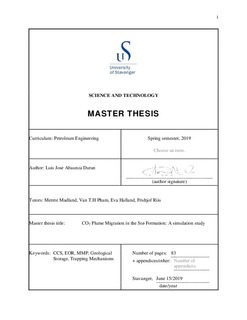| dc.contributor.advisor | Madland, Merete | |
| dc.contributor.advisor | Halland, Eva | |
| dc.contributor.advisor | Pham, Van | |
| dc.contributor.advisor | Riis, Fridtjof | |
| dc.contributor.author | Abaunza, Luis Jose | |
| dc.coverage.spatial | Norway, Hammerfest basin | nb_NO |
| dc.date.accessioned | 2019-12-18T08:58:05Z | |
| dc.date.available | 2019-12-18T08:58:05Z | |
| dc.date.issued | 2019-06-15 | |
| dc.identifier.uri | http://hdl.handle.net/11250/2633819 | |
| dc.description | Master's thesis in Petroleum Engineering | nb_NO |
| dc.description.abstract | The need for improving the quality of our environment by reducing CO2 emissions and in the meantime increasing the recovery of hydrocarbons could be a mutually beneficial situation. Therefore, having additional reserves that eventually would be commercialized, can generate additional profits that can be achieved with carbon capture sequestration (CCS). In addition, the companies could have CO2 tax reduction due to the volume of CO2 injected in geological formations. Some countries encourage to use this smart solution for controlling emissions in the atmosphere after the Paris agreement of 2016.
The Snøhvit field is located in the central part of the Hammerfest Basin in the Barents Sea and the reservoirs were found in the Stø and Nordmela Formations. The hydrocarbon phase in the Snøhvit main field is largely gas with a 10 to 15-meter-thick oil phase. In 2011, the Stø formation was perforated as a new storage location for carbon dioxide, since then all of the CO2 from the Snøhvit field has been injected in the water zone of the Stø formation, which is in pressure communication with the gas producers on Snøhvit, with no expected pressure buildup in the injection site.
It is probable that the direction of the CO2 plume will be towards the west and it is believed that this front can be used to mobilize residual oil, which is abundant in the Realgrunnen subgroup. The purpose of this study is to understand the behavior of the carbon dioxide in the zone of interest by using a reservoir simulation software. Notwithstanding there is uncertainty if it would be a miscible or immiscible flood taking into consideration the relative permeabilities of the CO2 with the oil. For in future allowing to deliver better alternatives in the study of generating a more efficient recovery. | nb_NO |
| dc.language.iso | eng | nb_NO |
| dc.publisher | University of Stavanger, Norway | nb_NO |
| dc.relation.ispartofseries | Masteroppgave/UIS-TN-IEP/2019; | |
| dc.subject | petroleumsteknologi | nb_NO |
| dc.subject | petroleum engineering | nb_NO |
| dc.subject | CCS | nb_NO |
| dc.subject | EOR | nb_NO |
| dc.subject | MMP | nb_NO |
| dc.subject | geological storage | nb_NO |
| dc.subject | trapping mechanisms | nb_NO |
| dc.title | CO2 Plume Migration in the Stø Formation: A simulation study | nb_NO |
| dc.type | Master thesis | nb_NO |
| dc.subject.nsi | VDP::Technology: 500::Rock and petroleum disciplines: 510::Petroleum engineering: 512 | nb_NO |
